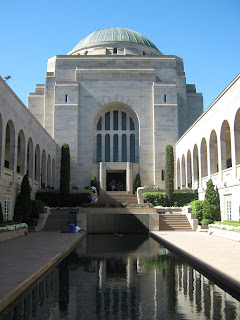As in the US, in Australia there’s a healthy competition between states. Warring New South Wales and Victoria are like typical siblings. Fighting and trying to best each other. There’s a particularly spirited rivalry between the two major cities of Melbourne and Sydney. Sydneysiders smirk when you mention you’re from Melbourne and Melbournians offer a malevolent sneer when anyone mentions the ‘evil city’ Sydney. Continuing along the family theme, if VIC and NSW are siblings then Queensland is the dumb blonde cousin - everyone rolls their eyes if some banana bender from Brisbane tries to sound intelligent. As for Tasmania, the small island state to the south, they are the ‘hicks’ - inbred and married to their first cousin. Am sure you get the picture so we won't even go into the sandgropers from WA or the troppo buffoons from NT.
Back to Canberra. The ACT is almost entirely made up of Canberra, the nation’s capital. Canberra was selected as the capital because Sydney and Melbourne both wanted the honor. More importantly, each city didn’t want the other one to end up as capital, so it was finally agreed (in 1901) that neither Sydney or Melbourne would be the Seat of Government of the Commonwealth. Furthermore, Melbourne insisted the capital had to be at least one hundred miles from Sydney. So, from 1902 to 1908 over 40 districts were proposed as possible capitals. The number was whittled down to 23 and then to 7 and, based on multiple criteria (sufficient water supply, climate, etc), Canberra was eventually chosen. Once the location was set, the next step was to design the capital city. Australia ran an international competition to select a city designer. Walter Burley Griffin, a landscape architect – and Yank from Chicago and disciple of Frank Lloyd Wright - won.
Burley Griffin's plan was to leverage the natural landform, waterways, and hilly undulations to create a city. A taxi driver told us Burley Griffin’s view was the government should serve the people so the civic buildings shouldn’t be “above” the eye level (ie on top of a hill like many castles) but at eye level – a government to serve its people and peers. In addition, Burley Griffin incorporated many Usonian principles dear to Frank Lloyd Wright in his designs. Central to his plan was a large artificial lake and a 'parliamentary triangle' for the most important national buildings. The surrounding city would be circular and radial in shape, which would fit the general topography of Canberra. We’re now up to 1911 and it wasn’t until 1913 when the first foundation stone was actually laid. Soon after WWI broke out – lack of funding slowed the city’s progress. Frustrated by many delays, Burley Griffin left Canberra in 1920 - 7 years before the Parliament building was completed. The Great Depression brought about more financial constraints and so it wasn’t until the 40’s and 50’s when national buildings – including a magnificent War Memorial - were finished.
Canberra today has the huge lake - Lake Burley Griffin - at its heart and huge circular streets (the city looks like crop circles from the air) and a long wide boulevard – on one end is the War Memorial – on the other the new Parliament House with the Old Parliament building about mid-way between.
The War Memorial is sensational. A fantastic tribute to the diggers and all of Australia’s armed forces. They have tutorials on the wars, exhibits, relief maps, pictures, recordings, video, and plenty of docents offering assistance. The memorial closes each day with a moment of silence and lone trumpeter playing the Last Post. Very powerful and incredibly moving.

Wall of names - fallen soldiers at War Memorial
 War Memorial
War MemorialOld Parliament House was the home of the Federal Parliament starting in 1927. From the beginning Old Parliament was to be the “temporary” home of government - albeit for 50 years - and would house approximately 300 politicians and staff. By the time the new Parliament was completed in 1988 the Old Parliament was crammed with 3,000 staffers.
A quick word about Aussie politicians. Being a commonwealth country, Australian politics have similar parliamentary traditions as the UK. Politicians will boo, hiss, harrumph and engage in colourful name-calling during opponents speeches. We have your typical gamut of politicians – glib and clever; the ignoble, your milquetoast variety, the idiots. One candidate from the Liberal party (conservative) recently announced he could have won the election that John Howard lost in a land slide… if only he had listened to his wife’s advice to run. One perpetual candidate campaigning in Queensland just had nude pictures of her splashed over the TV, newspapers, and Internet. Her spokesperson, in usual unruffled Aussie fashion said, “She doesn’t care.” That is, she didn’t care until she realised the pictures were not of her after all. A debate ensued and she got a formal retraction. Of course considering her initial response we all know she did indeed – at some point - pose for nude pictures.
New Parliament – the interior is very much a celebration of all things Aussie. A gorgeous and impressive building that uses various Australian timbers and numerous displays of Australian art and craftwork. The color scheme also reflects the land of Oz - The House of Representatives is the color of eucalyptus; the Senate color resembles the red earth.
We don’t think we’ll ever work for the Canberra tourist bureau but it was worthy of a visit and, to say we’ve got 8 for 8 Aussie states, is the bonus.

No comments:
Post a Comment